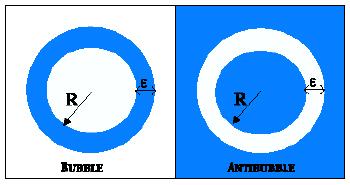Belle Dumas, Physicsweb (translation: Dikla Oren)

Direct link to this page: https://www.hayadan.org.il/antibuble.html
Physicists from Belgium used a high-speed video camera to watch "anti-bubbles" form, move and then explode in a liquid for the first time. Stéphane Durbulo and his colleagues from the University of Liège created the anti-bubbles in a variety of liquids - including soapy water and beer - and their findings may help physicists deepen their understanding of the physics of liquids. Although they were observed for the first time in 1932, not much is known about the way they formed and collapsed.
A bubble is a spherical membrane of liquid, which surrounds an air pocket and is surrounded by air itself. An anti-bubble, as its name suggests, is an air shell, outside of which there is liquid (see Figure 1). While scales rise to the surface of the liquid, anti-bubbles sink to the bottom.
To create the anti-bubble Durbolo and his colleagues slowly poured a small amount of a mixture, made of water and soap, onto a glass tray, which contained the same liquid. They came to know that a jet of liquid globules was formed below the surface of the liquid, and the jet broke up and created a stream of anti-bubbles, which lasted up to two minutes (see diagram 2).
The anti-bubbles then burst in a similar manner to normal bubbles (see diagram 3). Durbulo and his research colleagues say that the responsible for the formation and collapse of anti-bubbles are irregularities in the liquid - the well-known "Reilich-Platio" and "Richtmeier Meshkov" irregularities.
The team also created anti-bubbles in beer and salt solutions "for fun".
Link to the original article on PhysicsWeb
Physics expert
https://www.hayadan.org.il/BuildaGate4/general2/data_card.php?Cat=~~~736352565~~~95&SiteName=hayadan
